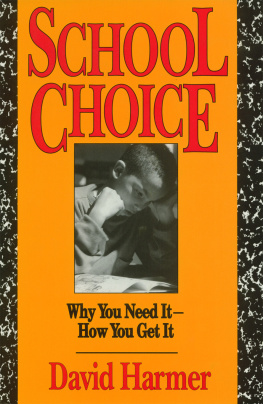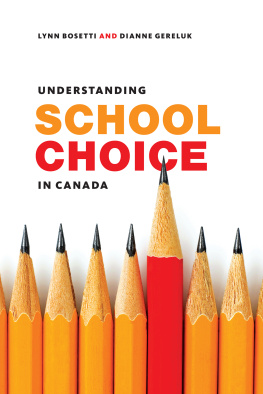
SCHOOL CHOICE
SCHOOL CHOICE
Why You Need It - How You Get It
David Harmer
INSTITUTE
Washington, D.C.
Copyright 1994 by the Cato Institute.
All rights reserved.
Library of Congress Cataloging-in-Publication Data
Harmer, David, 1962-
School choice: why we need it, how we get it / David Harmer.
p. cm.
Includes bibliographical references and index.
ISBN 1-882577-14-0 : $22.95 - ISBN 1-882577-15-9 : $12.95
School choice-United States. 2. School choice-California
3. Educational vouchers-Law and legislation-United States.
4. Educational vouchers-Law and legislation-California. I. Title. LB1027.9.H37 1994
CIP
Cover Design by Colin Moore.
Printed in the United States of America.
C ATO I NSTITUTE
1000 Massachusetts Ave., N.W.
Washington, D.C. 20001
To My Father,
John L. Harmer
Preface
On November 2, 1993, the Parental Choice in Education Initiative appeared on California's statewide ballot as Proposition 174. Although defeated, this initiative focused renewed attention on the persistently poor performance of the public schools and the need for alternatives to them. Proposition 174 is already serving as a model for school choice efforts in other states. This book, which contains the full text of the initiative and a thorough explanation of issues surrounding it, should be a useful guide to proponents of such efforts.
The book had its genesis in the heat of the drive to qualify the initiative for the ballot. Late in 1991 I left my law firm to serve as president of the Excellence Through Choice in Education League (ExCEL). For the better part of the following year I was the initiative's full-time advocate, promoting it in public speeches, on radio talk shows, and in televised debates throughout the state. During these appearances I found myself answering the same questions repeatedly and assuaging the same fears. It became apparent that existing materials did not adequately explain the need for school choice or answer the arguments against it. Even our supporters lacked the information they needed to be effective advocates.
This book attempts to fill that void.
Every child deserves the benefits that come through school choice. I hope this book will help persuade legislators and voters to make those benefits available.
-David J. Harmer
May 3, 1994
Author's Notes
My analysis of the condition of public education draws on evidence and examples from throughout the nation. Whenever possible, however, I illustrate my points with personal experience. In doing so, of necessity I discuss events and circumstances in California, particularly in the Los Angeles Unified School District (LAUSD). Since I resided within LAUSD boundaries during my tenure as president of ExCEL, it is the district with which I am most familiar. Some might argue that LAUSD, as a massive and deeply troubled urban district, is atypical. Perhaps so, yet its fundamental problems, both exogenous (rising violence, declining family stability) and structural (unwieldy bureaucracy, cumbersome regulation), are shared by most public school systems nationwide.
* * *
Schools are usually categorized as either "public" or "private." This book instead categorizes them as "government" or "independent."
"Public" schools are operated by governmental entities. Funded through compulsory taxation, they charge no tuition. Thus any student, regardless of economic status, may attend. "Private" schools, in contrast, are operated by nongovernmental entities. Lacking the guaranteed tax revenues of the "public" schools, they must charge tuition. Thus, as a rule, only students from families able to make the necessary financial sacrifice may attend.
Under school choice these distinctions blur, and the usual labels become misleading. School choice levels the playing field. All students would be eligible to receive tuition vouchers worth a certain percentage of the per-pupil cost of "public" schooling. They could then redeem the vouchers at any qualified school. Ideally, "public" schools would be funded only to the extent that parents voluntarily chose to enroll their children there, and "private" schools could accept tax-funded vouchers, thus enabling more low- and middle- income students to enroll. In short, "public" schools would need to compete more like "private" schools, and "private" schools could be funded more like "public" schools.
For the sake of clarity, this book identifies any school operated by a traditional governmental entity as a "government" school. All other schools are identified as "independent" schools, regardless of the ultimate sources of their funding. These terms apply under the present system and under school choice with equal accuracy.
* * *
References to government schools should be understood as including all kindergarten through 12th grade education funded and operated by the state and its subdivisions. References to government schools exclude higher education unless otherwise noted. References to independent schools should be understood as including all non-government kindergarten through 12th grade schools. Home schools mayor may not be included, depending on the context. Average independent school tuition calculations generally exclude home school students, who would bring the average even lower. Overall . independent school enrollment calculations generally include home school students.
P ART I
T HE N EED F OR S CHOOL C HOICE
Introduction:
The Greatest Force
I grew up in pleasant suburbs, but from 1990 through 1992 I belonged to an inner-city church. It was an education. Located a block from the intersection of Western Avenue and Pico Boulevard in Los Angeles, our building rarely survived a week without being defaced by spray-painted graffiti. After the Rodney King riots the neighborhood looked like a Third World war zone, but frankly it didn't look much better before. Our congregation was racially mixed, mostly poor, and full of the warmest and finest in human nature. Outside of my own family I have never met more loving people. For two years they were my neighbors. They will always be my friends.
While living in central Los Angeles I spent a night or two every week doing volunteer work, which took me into the homes of church members and their neighbors. I met Chuck and Tammy Woodhouse, who paid $1,900 a year to send their daughter to a Catholic school. They weren't Catholic, but their little girl was safe there, and she was actually learning. They couldn't be sure of either in the government school.
Many other parents I met desperately wanted to do what Chuck and Tammy had done; they wanted to send their children to better, safer schools. But they couldn't afford them.
Several black pastors in the area were so dismayed by the dismal quality of government schools in their neighborhoods that they were establishing bare-bones independent schools through their churches. Fundraising is a struggle anywhere, but imagine trying to do it in south central Los Angeles. They undertook this almost impossible task because they wanted their kids to be safe, cared for, and taught.
 SCHOOL CHOICE
SCHOOL CHOICE 











